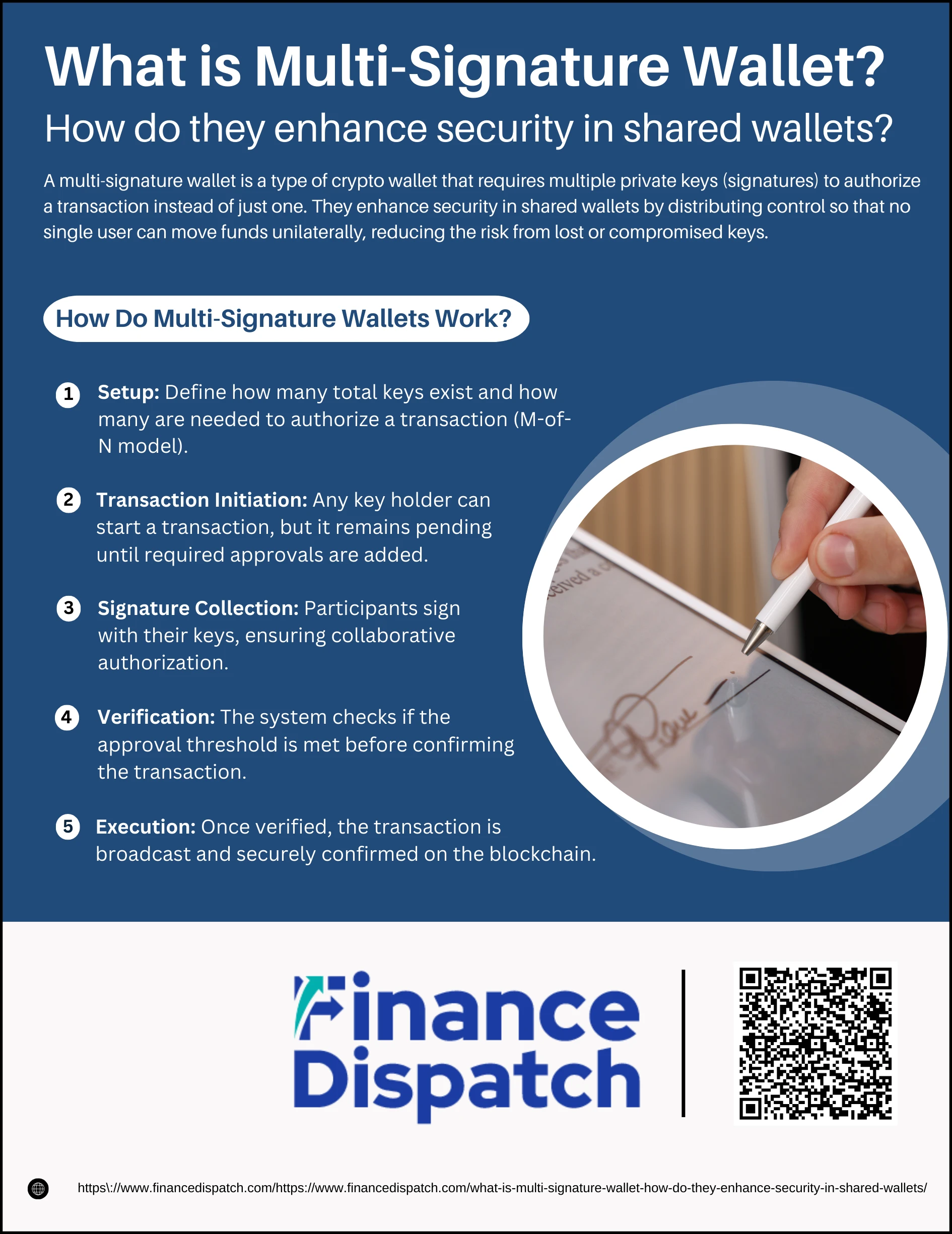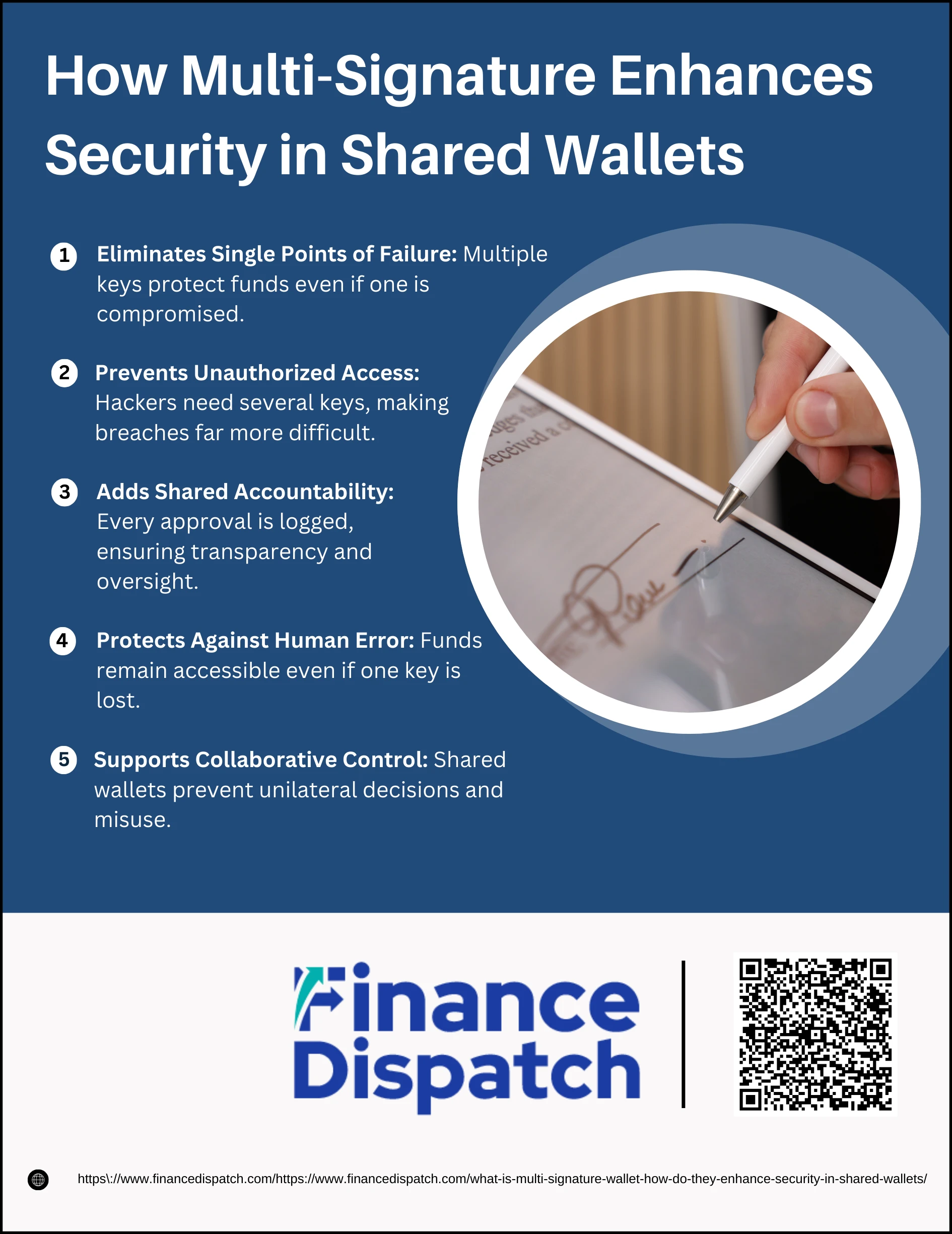In the fast-evolving world of cryptocurrency, one of the biggest challenges investors and organizations face is keeping their digital assets safe. Traditional wallets secured by a single private key can be convenient, but they leave funds vulnerable to theft, hacking, or simple human error. A single compromised key can mean the loss of everything. This is where multi-signature wallets, often called multisig wallets, come in. By requiring two or more approvals before any transaction is executed, they add a powerful layer of protection and ensure that no single person has full control over shared assets. Whether used by businesses, families, or decentralized communities, multi-signature wallets offer a practical solution to enhance security, build trust, and reduce risks in managing crypto holdings.
What is a Multi-Signature Wallet?
A multi-signature wallet, often shortened to multisig wallet, is a type of cryptocurrency wallet that requires more than one private key to authorize a transaction. Unlike a traditional wallet that depends on a single signature for access, a multisig wallet uses an “M-of-N” setup—meaning out of a set number of keys (N), a minimum number (M) must approve before funds can be moved. For example, in a 2-of-3 arrangement, three keys exist but only two are required to complete a transaction. This shared authorization model distributes control, making it far more secure against theft, fraud, or misuse, especially when digital assets are held jointly by partners, organizations, or custodial services.
 How Do Multi-Signature Wallets Work?
How Do Multi-Signature Wallets Work?
Multi-signature wallets rely on the idea that security and control are stronger when shared. Instead of giving one person full authority to move funds, they require multiple approvals before a transaction is completed. This model distributes trust, reduces the risk of theft, and creates a more transparent process for managing digital assets.
Step-by-Step Process:
1. Setup
When creating a multisig wallet, the participants decide how many total keys (N) will exist and how many of them (M) are required to authorize a transaction. This is called the M-of-N setup. For example, in a 2-of-3 arrangement, three keys are generated, and any two must be used to approve transactions. This structure ensures flexibility while balancing security and convenience.
2. Transaction Initiation
Anyone who holds one of the private keys can initiate a transaction, such as sending cryptocurrency to another address. However, the transaction will not go through immediately. Instead, it is placed in a pending state, waiting for the required number of signatures. This pending status ensures that no funds move without collective agreement.
3. Signature Collection
Each designated participant must approve the transaction by signing it with their private key. The system records and validates each signature against the preconfigured rules. In a 2-of-3 wallet, for instance, two of the three participants must provide their signatures. This step ensures that authorization is collaborative and prevents unilateral control.
4. Verification
Once enough signatures are provided, the wallet software or blockchain protocol verifies that the correct number of approvals has been met. If the threshold is satisfied, the transaction is considered valid. If not, the transaction remains incomplete until the required number of signatures is obtained.
5. Execution
After verification, the transaction is broadcast to the blockchain network. The blockchain confirms it just like any other transaction, but with the added assurance that multiple parties approved it. This final step ensures that the transfer of funds is secure, transparent, and compliant with the multisig rules.
 How Multi-Signature Enhances Security in Shared Wallets
How Multi-Signature Enhances Security in Shared Wallets
Multi-signature wallets are designed with collaboration in mind. Instead of relying on one person to safeguard shared digital assets, they spread responsibility across multiple signers. This approach not only increases security but also builds trust, making them especially valuable for businesses, organizations, and families who manage funds together.
Ways Multi-Signature Enhances Security:
1. Eliminates Single Points of Failure
In a single-signature wallet, everything depends on one private key. If that key is lost, stolen, or compromised, the funds are gone forever. Multi-signature wallets solve this by requiring multiple approvals. Even if one key is exposed, attackers still cannot move the funds without the other required keys. This redundancy is particularly useful for high-value accounts where security is critical.
2. Prevents Unauthorized Access
Hackers often target a single user or device to steal private keys. With multisig, however, they would need to compromise multiple keys stored across different people, devices, or even locations. For example, in a 2-of-3 wallet, stealing one key gives them nothing—two keys are still required. This drastically reduces the chances of unauthorized access, making it far harder for bad actors to succeed.
3. Adds Shared Accountability
Multi-signature setups create transparency because transactions cannot be completed without collective approval. Every signer leaves a record of participation, ensuring all parties know who approved a transaction. This audit trail discourages misuse and creates accountability, which is especially valuable in group or organizational settings.
4. Protects Against Human Error
Human mistakes are common in crypto security, such as misplacing a private key or forgetting a password. In single-key wallets, that mistake could mean losing all access to funds. Multisig wallets mitigate this risk. As long as the threshold number of keys is available, transactions can still be authorized. For example, if one key in a 3-of-5 wallet is lost, the other four can still approve transfers.
5. Supports Collaborative Control
Shared wallets are often used by businesses, decentralized autonomous organizations (DAOs), or families managing joint funds. By requiring multiple signers, multisig ensures that no single person can act alone. This prevents one individual from draining the wallet or making unilateral decisions. Instead, it fosters collective responsibility, making fund management more secure, transparent, and fair.
Multi-Signature Wallets vs. Single-Signature Wallets
The main difference between single-signature wallets and multi-signature wallets lies in how transactions are approved. A single-signature wallet depends on one private key, which makes it simple but vulnerable—if that key is compromised, funds can be stolen. Multi-signature wallets, on the other hand, require multiple approvals, distributing responsibility and significantly reducing the risk of unauthorized access.
Comparison Table:
| Feature | Single-Signature Wallet | Multi-Signature Wallet |
| Security | Relies on one key; higher risk of theft or loss | Requires multiple keys; stronger protection against attacks |
| Control | Full authority rests with one user | Shared control among multiple signers |
| Ease of Use | Simple setup and management | More complex; requires coordination between users |
| Recovery Options | Lost key means permanent loss of funds | Still accessible if enough keys remain to meet the approval threshold |
| Best Use Case | Everyday transactions and small amounts | Businesses, DAOs, family funds, or large holdings needing extra security |
Key Features and Goals of Multi-Signature Wallets
Multi-signature wallets are built to address the risks that come with managing valuable digital assets. By requiring multiple approvals for every transaction, they not only increase security but also promote transparency and shared responsibility. These features make them especially useful in collaborative environments, such as businesses, families, and decentralized organizations.
Key Features and Goals:
1. Enhanced Security: Eliminates the vulnerability of a single private key by requiring multiple approvals.
2. Customizable Signatory Rules: Users can set flexible requirements, such as 2-of-3 or 3-of-5, depending on their needs.
3. Shared Control: Prevents any single party from having full authority over funds, ensuring balanced decision-making.
4. Fraud Prevention: Multiple approvals act as safeguards against internal misuse or unauthorized access.
5. Transparency and Accountability: Every signer’s participation is recorded, creating a clear audit trail.
6. Backup and Recovery Options: Even if one key is lost, assets remain secure as long as the signature threshold is met.
7. Collaborative Security Model: Similar to scenarios where two people must turn keys simultaneously, ensuring collective responsibility.
 Advantages of Multi-Signature Wallets
Advantages of Multi-Signature Wallets
Multi-signature wallets go beyond standard wallet security by adding layers of protection, accountability, and flexibility. They are particularly useful when funds are shared among multiple people, or when the value of assets demands stronger safeguards than a single private key can provide.
Key Advantages:
1. Stronger Security
Unlike single-signature wallets, a multisig wallet does not allow one private key to authorize a transaction. This means that even if a hacker gains access to one key, they cannot steal funds without the additional required keys. The multi-approval process acts as a natural barrier against theft and unauthorized activity.
2. Prevents Single Points of Failure
In a single-key setup, losing or compromising that one key could mean losing all access to your funds. Multi-signature wallets solve this problem by distributing control. For example, in a 2-of-3 setup, if one key is lost, the other two keys can still be used to access and manage the funds. This redundancy makes the system more resilient.
3. Shared Control and Trust
Multisig wallets ensure that no single person has complete authority over the wallet’s contents. In businesses or group projects, this prevents unilateral decisions and enforces collaboration. Every transaction requires agreement from multiple people, which builds trust among participants and reduces the risk of misuse.
4. Built-in Transparency
Each signer’s approval is recorded, creating an auditable history of who authorized which transaction. This is especially valuable for organizations, as it provides clear accountability and makes it easier to monitor financial activity. Transparency discourages internal fraud and fosters a higher level of trust among stakeholders.
5. Protection Against Human Error
Human mistakes, such as losing a password or misplacing a private key, are common causes of lost cryptocurrency. Multisig wallets reduce this risk. As long as the minimum number of required keys is available, the funds remain accessible, preventing accidental lockouts that often occur in single-key wallets.
6. Versatility for Groups and Businesses
These wallets are flexible enough to be used in different setups—like 2-of-3 for small partnerships, or 3-of-5 for larger organizations. They are ideal for companies managing treasuries, families managing shared wealth, or decentralized autonomous organizations (DAOs) that require democratic approval for spending. This makes them one of the most practical tools for collaborative fund management in crypto.
Challenges and Limitations of Multi-Signature Wallets
While multi-signature wallets greatly improve security and accountability, they also introduce new hurdles that users need to carefully consider. These challenges often stem from the added complexity of requiring multiple approvals and managing several private keys. For beginners or organizations without proper planning, these limitations can affect usability and efficiency.
Key Challenges and Limitations:
1. Technical Complexity: Setting up and managing multisig wallets requires more technical knowledge compared to single-signature wallets.
2. Coordination Issues: Transactions may be delayed if one or more signers are unavailable or unwilling to approve.
3. Key Recovery Risks: If too many keys are lost, access to funds may be permanently blocked.
4. Compatibility Limitations: Not all wallets, platforms, or exchanges support multisig functionality.
5. Higher Transaction Fees: Each added signature increases the transaction size, leading to higher blockchain network fees.
6. Slower Speed: Because multiple parties must approve, multisig transactions are less suited for urgent or time-sensitive transfers.
7. Human Dependency: Security relies not only on technology but also on the cooperation and reliability of all key holders.
Real-World Use Cases of Multi-Signature Wallets
Multi-signature wallets aren’t just a theoretical security tool—they are actively used across the cryptocurrency ecosystem to solve practical problems. From businesses managing treasuries to individuals planning inheritance, multisig structures offer a balance of security, transparency, and shared control that fits many real-world scenarios.
Common Use Cases:
1. Corporate Treasury Management: Businesses use multisig wallets to ensure multiple executives approve large transactions, reducing fraud risks and enforcing accountability.
2. Escrow Services: Multisig wallets allow buyers, sellers, and a neutral third party to hold funds securely until all parties agree to release them.
3. Joint Accounts for Families or Partners: Couples, families, or business partners can manage shared assets collectively, ensuring no one person can move funds alone.
4. Decentralized Autonomous Organizations (DAOs): DAOs rely on multisig wallets for transparent and democratic control over community treasuries.
5. Exchange Fund Protection: Crypto exchanges use multisig to secure customer assets, requiring multiple internal approvals to prevent internal theft or hacking losses.
6.Inheritance and Estate Planning: Keys can be distributed among trusted family members or executors, ensuring secure transfer of digital assets after death.
Conclusion
Multi-signature wallets represent a major step forward in securing and managing digital assets, especially when funds are shared among multiple parties. By requiring more than one approval for every transaction, they eliminate single points of failure, discourage unauthorized access, and promote accountability. While they come with added complexity, higher fees, and the need for coordination, the benefits far outweigh the drawbacks for businesses, organizations, and individuals managing significant or joint holdings. In essence, multi-signature wallets strike a balance between security and collaboration, making them an essential tool for those who want to protect their cryptocurrency with greater confidence.



